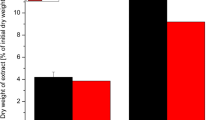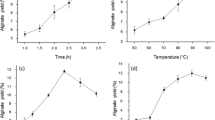Abstract
Formaldehyde is usually added to brown algae to avoid microbial growth during storage and to fix polyphenols in the algae before alginate extraction. Since formaldehyde is toxic, allergenic and possibly carcinogenic, dry salting of Ascophyllum nodosum was tested as an alternative. The seaweeds, harvested at locations with a salinity of about 30‰ from late autumn to early spring, were stored at 22±2 °C under compost-like conditions. Untreated samples of seaweed lost their quality as a raw material for alginate production within 14 days. Salted (20–22%) as well as formaldehyde treated seaweed was preserved for at least 46 days. Due to the reduced water activity and oxygen saturation in the dry salted seaweed, microbial growth and brown colouring reactions were suppressed. Economic factors must also be taken into account before large-scale applications are considered.
Similar content being viewed by others
References
Butler DM, Østgaard K, Boyen C, Evans LV, Jensen A, Kloareg A (1989) Isolation conditions for high yields of protoplasts from Laminaria saccharina and L. digitata (Phaeophyceae). J. exp. Bot. 40: 1237–1246.
Chapman VJ, Chapman DJ (1980) Seaweeds and their Uses. Chapman and Hall, London: 194–225.
Haug A (1964) Composition and properties of alginates. Rep. Norw. Inst. Seaweed Res. No. 30. Laboratory of Biotechnology, Trondheim: 10–25.
Haug A, Larsen B (1958) The formation of brown coloured substances in seaweed and seaweed extracts. Rep. Norw. Inst. Seaweed Res. No. 22. Laboratory of Biotechnology, Trondheim: 1–18.
Holt JG, Krieg NR (1994) Enrichment and isolation. In Gerhardt P, Murray RGE, Wood WA, Krieg NR (eds), Methods for General and Molecular Bacteriology. American Society for Microbiology, Washington DC: 179–215.
Jensen A (1995) Production of alginate. In Wiessner W, Schnepf E, Starr RC (eds), Algae, Environment and Human Affairs. Biopress Ltd., Bristol: 79–92.
Larsen B (1978) Brown Seaweeds: Analysis of ash, fiber, iodine and mannitol. In Hellebust JA, Craigie JS (eds), Handbook of Phycological Methods – Physiological and Biochemical Methods. Cambridge University Press, Cambridge: 181–188.
Moen E (1997) Biological degradation of brown seaweeds. PhD thesis, Department of Biotechnology, NTNU, Trondheim: 43–51.
Rødde RSH (1997) Chemical composition and alginate biosynthesis in protoplasts from Laminaria digitata and Laminaria saccharina. PhD thesis. Department of Biotechnology, NTNU, Trondheim: 19–31.
Author information
Authors and Affiliations
Rights and permissions
About this article
Cite this article
Moen, E., Larsen, B., Østgaard, K. et al. Alginate stability during high salt preservation of Ascophyllum nodosum. Journal of Applied Phycology 11, 21–25 (1999). https://doi.org/10.1023/A:1008077412543
Issue Date:
DOI: https://doi.org/10.1023/A:1008077412543




